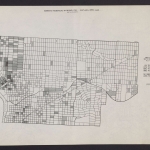Description
1945 map showing African American homes and businesses in Portland. A few clusters of homes and businesses are outside of the city limits of the time, notably in the city of Vanport near the Columbia River. There are other concentrations in central North/Northeast Portland, where the Memorial Coliseum and Emanuel Hospital were later built; and in Northwest Portland where the Guild's Lake wartime housing development was located. The map is part of a report assessing the state of the local African American community, entitled The Negro in Portland, which was published by the City Club of Portland in their July 20, 1945 City Club Bulletin.
Download Files
Collections with this item
Details
Transcription
Contributors
Digital Publisher
Subject.Topic
Subject.Place
Language
Rights & Usage
Rights undetermined (the copyright and related rights status of this work is unknown)
Identifier
- XXmap_000114
Type
Date.Range
Format.Original
File format
Shelf.Location
- OREGON 352 C58b v.23-26






















































Add new comment